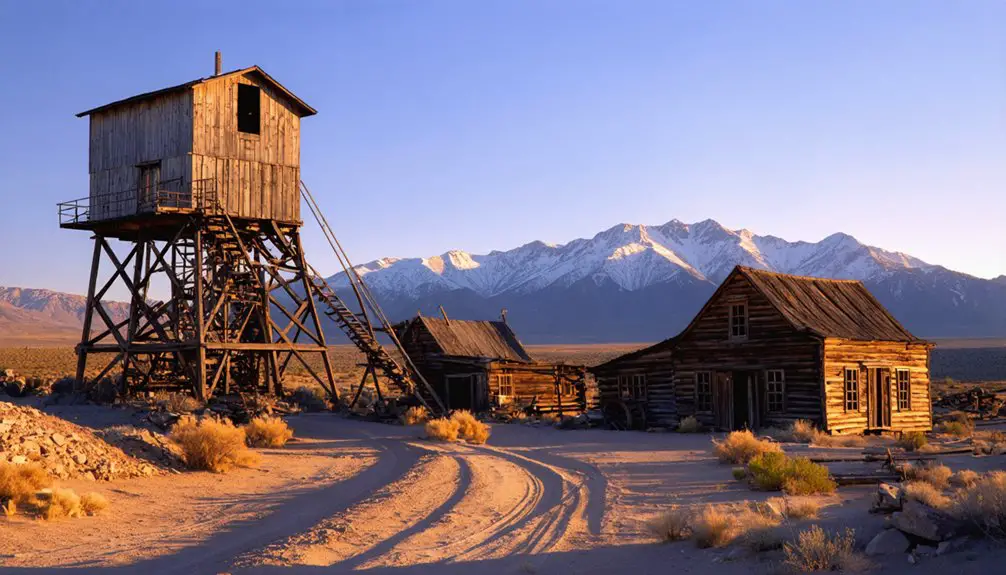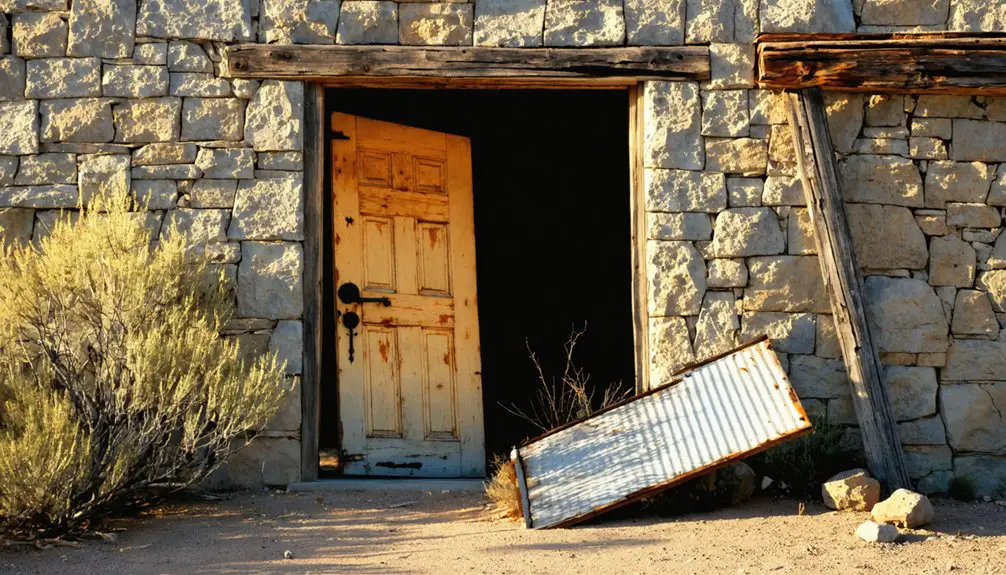You’ll discover Tybo, Nevada as a historically significant ghost town that thrived in the 1870s during Nevada’s silver mining boom. At its peak in 1876, this frontier settlement housed 1,000 residents and ranked second statewide in lead production, generating $50 million worth of silver ore by modern standards. A devastating fire in 1879 destroyed 32 buildings, leading to its decline. Today, you can explore remnants including the Trowbridge Store, mining structures, and fifteen preserved charcoal kilns.
Key Takeaways
- Tybo is an abandoned silver mining town in Nevada that peaked in 1876 with 1,000 residents before declining after a devastating fire.
- The ghost town features preserved structures including the Trowbridge Store, 1930s wooden buildings, and fifteen historic charcoal kilns.
- Located northeast of Tonopah, visitors can access Tybo via Highway 6 and a marked dirt road past the Extraterrestrial Highway junction.
- During its heyday, Tybo produced approximately $50 million worth of silver ore and ranked second statewide in lead output.
- The town’s rapid decline began after an 1879 fire destroyed 32 buildings and the closure of local smelters eliminated 400 jobs.
The Birth of a Mining Frontier
By 1874, Tybo had transformed from a simple mining camp into a burgeoning frontier town.
The establishment of the Tybo Consolidated Mining District in 1875 brought three major mines under unified control. A new smelter operation had already been constructed in 1872, paving the way for increased ore processing.
While the early days saw peaceful coexistence among Irish, Cornish, and Central European miners, cultural tensions emerged as the population grew to 1,000 residents by 1876. The town’s name reflected its mining heritage, derived from the Shoshone language term for white man’s district.
Glory Days and Peak Production
While several Nevada mining towns experienced brief moments of prosperity, Tybo’s glory days stood out during its remarkable peak production period from 1877 to 1881.
You’d find Tybo leading Nye County’s production and ranking second statewide in lead output. The town’s sophisticated ore processing and mining techniques attracted nearly 1,000 residents by 1876, transforming it into a bustling hub of activity. The town’s prosperity was supported by its charcoal kilns built in 1877 for essential smelting operations. A new 80-ton crushing mill replaced the existing smelters in 1879, further modernizing operations.
During this golden era, the mines yielded an impressive $50 million worth of silver ore in today’s value.
At its peak, Tybo’s silver mines produced a staggering $50 million in precious ore by modern standards.
However, you’ll notice how quickly fortunes can change in mining towns – by 1881, ore quality plummeted dramatically. The Tybo Consolidated Mining Company’s subsequent failure led to a mass exodus, leaving fewer than 100 residents by year’s end.
Life in a Multicultural Mining Camp
Although Tybo’s population peaked at around 1,000 residents in 1876, you’ll find its social fabric was distinctly divided among Irish, Cornish, Central European, and Chinese inhabitants.
The town’s layout reflected these divisions, with each ethnic group establishing its own district. While ethnic cooperation occasionally emerged, particularly when European groups united against Chinese settlement, social challenges and racial tensions intensified by the mid-1870s.
You’d see this tension play out in the town’s saloons, where verbal abuse and physical confrontations were common. The Tybo Consolidated Mining Company took control of major local mines in 1875, further intensifying workplace tensions.
Despite these conflicts, the community maintained civic institutions like schools, a literary society, and an IOOF lodge.
The town’s economy thrived through various businesses, though the Chinese remained restricted to charcoal production until anti-Asian sentiment forced their departure. The massive 30-foot-high kilns built in 1874 still stand today as testament to their industrious contributions.
The Great Fire and Gradual Exodus
Tybo’s decline accelerated dramatically when the devastating 1879 fire destroyed 32 buildings, effectively crushing any remaining hopes for the town’s immediate recovery during its ongoing mining difficulties.
You’ll find that despite attempts at revival, including the Louisiana Consolidated Mining Company‘s 1916 efforts and Treadwell-Yukon‘s 1929 modernization projects, the town never regained its former glory.
The final years of Tybo saw its population dwindle from a peak of 1,000 in 1876 to merely 100 by 1882, as residents abandoned the settlement for more promising opportunities elsewhere in the West. The closure of the local smelters in 1879 eliminated 400 jobs and accelerated the town’s downward spiral.
Fire’s Devastating Impact
Not long after mining operations ceased due to declining ore quality in the early 1880s, a catastrophic fire struck Tybo and destroyed approximately 32 buildings, including essential commercial structures and residential areas.
The fire aftermath devastated what remained of the town’s infrastructure, wiping out crucial services like the post office, stores, saloons, and blacksmith shops.
You’ll find that this destruction proved particularly devastating for community resilience, as the population had already dwindled to about 100 residents.
With key business structures reduced to ashes and the mining industry already in decline, you can understand why rebuilding became economically unfeasible.
The disaster effectively crushed any hopes of recovery, accelerating Tybo’s shift into a ghost town and discouraging former residents from returning to rebuild their lives.
Economic Recovery Attempts
When economic decline struck Tybo in 1879, the town launched several ambitious recovery attempts to salvage its mining-dependent economy.
You’ll find that despite the population plummeting from 1,000 to under 100 residents, the community invested in a new mill around 1880, though deteriorating ore quality quickly dampened these hopes.
The most notable revival came in 1929 when Treadwell-Yukon Company expanded operations from 75 to 180 workers, processing 500,000 tons of lead ore over eight years.
However, persistent economic challenges, including low metal prices and steep living costs, undermined long-term stability.
Community tensions between Irish, Cornish, and Central European miners, along with discrimination against Chinese workers, further complicated recovery efforts.
Despite producing $6.8 million in lead and silver ore between 1929-1937, Tybo’s mining operations ultimately proved unsustainable. A devastating July 4, 1884 fire destroyed most of the town, causing $30,000 in damages and further hindering recovery efforts.
Town’s Final Years
A devastating fire in the early 1880s marked the beginning of Tybo’s final decline, destroying 32 buildings and shattering any remaining hopes for economic recovery.
You’ll find that by 1882, the town’s population had already dwindled to about 100 people, as deteriorating ore quality prompted mass departures to other Western boomtowns.
The social dynamics of Tybo’s final years reflected deep community fragmentation.
Tensions between Irish, Cornish, and Central European immigrants erupted in conflicts, while anti-Chinese violence in 1876 exposed underlying racial hostilities.
You’ll notice how these social pressures, combined with failing infrastructure and closed businesses, accelerated the town’s transformation into a ghost town.
Despite brief mining revivals in 1916 and the late 1920s, Tybo never recaptured its former liveliness.
Standing Remnants of the Past
Today’s visitors to Tybo can explore numerous historical structures that have withstood over a century of abandonment. The architectural preservation of the Trowbridge Store stands as a representation to late 19th-century construction, with its original roof and window glass still intact.
You’ll find several 1930s wooden structures, including a large bunkhouse and smaller houses, that highlight the town’s historical significance during its mining revival period. A devastating fire in 1884 permanently altered the town’s original appearance. The area includes two occupied homes and a travel trailer among the abandoned buildings.
A unique sod-roof house built from railroad ties perches on a nearby hillside, while concrete foundations and brick walls dot the sagebrush-covered landscape.
The site’s industrial heritage remains visible through surviving metal headframes, remnants of mining operations, and the fifteen charcoal kilns in adjacent canyons.
Though privately owned, the kilns on U.S. Forest Service land remain accessible for exploration.
Planning Your Visit to Tybo Today

Planning a trip to Tybo Ghost Town requires careful preparation due to its remote desert location northeast of Tonopah, Nevada.
You’ll find access routes via Highway 6, traveling east about 50 miles past the Extraterrestrial Highway junction, then turning onto a marked dirt road. While the main access road accommodates standard vehicles, you’ll want to monitor weather conditions that can affect road quality.
Key visitor considerations for your desert adventure:
- Bring essential supplies including water, navigation tools, and proper footwear as there aren’t any on-site amenities.
- Plan your exploration during daylight hours and inform others of your itinerary due to limited cell coverage.
- Respect private property boundaries while photographing historic structures, and stay clear of dangerous mine shafts.
Frequently Asked Questions
Were There Any Notable Shootouts or Criminal Incidents in Tybo’s History?
You’ll find no major shootout history in official criminal records, though ethnic violence between Chinese workers and European settlers led to smaller-scale fights, killings, and unmarked graves in Tybo.
What Happened to the Original Mining Equipment and Machinery After Abandonment?
You’ll find mining relics scattered across the site today, as most equipment was either salvaged for metal, left to deteriorate naturally, or replaced during later revivals between 1916-1937.
Are There Any Reported Ghost Sightings or Paranormal Activity in Tybo?
You won’t find documented ghost encounters or paranormal investigations in Tybo. While the town’s abandoned structures create an eerie atmosphere, there’s no credible evidence of supernatural activity in available records.
How Did the Winter Weather Affect Mining Operations in Tybo?
You’ll find winter challenges severely impacted mining productivity through icy roads, equipment strain, and worker safety risks, while snow and freezing temperatures forced periodic shutdowns and increased operational costs.
Did Any Famous Historical Figures Ever Visit or Stay in Tybo?
Like a lone tumbleweed in the desert, you’ll find no records of famous visitors in this mining town. Historical significance stems from its diverse immigrant workers rather than celebrity appearances.
References
- https://www.backroadswest.com/blog/tybo-ghost-town-and-project-faultless/
- https://www.legendsofamerica.com/nv-tybo/
- https://travelnevada.com/ghost-town/tybo-ghost-town/
- https://www.youtube.com/watch?v=vUt4f1cUWZU
- https://pinintheatlas.com/travel-blogs/tybo-ghost-town-nevada/
- https://www.atlasobscura.com/places/tybo
- https://www.nevadaappeal.com/news/2014/sep/25/ghost-town-of-tybo-offers-history-scenery/
- https://www.nvexpeditions.com/nye/tybo.php
- https://erikjengh.wordpress.com/category/everydays-nevada-day-to-me/tybo/
- https://www.mininghistoryassociation.org/TonopahGoldMineCamps.htm



